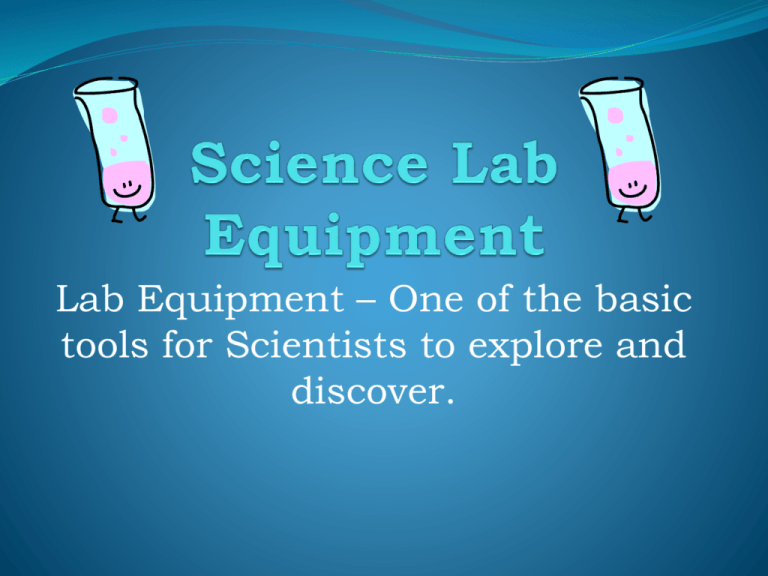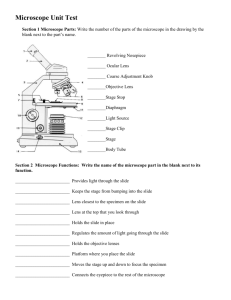Lab Equipment Power Point
advertisement

Lab Equipment – One of the basic tools for Scientists to explore and discover. Beaker a flat-bottomed cylindrical container, usually with a pouring lip, to measure, mix, and prepare liquids. Test Tube a hollow cylinder of thin glass with one end closed, used for experiments in labs. Flask a bottle, usually of glass, having a rounded body and a narrow neck, used especially in laboratory experimentation. Graduated Cylinder a narrow, cylindrical container marked with horizontal lines to represent units of measurement and used to precisely measure the volume of liquids. Microscope an optical instrument having a magnifying lens or a combination of lenses for inspecting objects too small to be seen or too small to be seen distinctly and in detail by the unaided eye. Test Tube Holder A plastic holder used to hold test tubes or dry them. Magnifying Glass lens that produces an enlarged image of an object. Hot Hands A set of protective hand wear to use for hot lab equipment. Microscope Slide and Cover Slip A glass or plastic rectangular slide that is used for specimens to be looked at under a microscope. A Cover Slip is used to place over the specimen on the Microscope Slide. This holds it in place. Pipette or Dropper a slender graduated tube used in a laboratory for measuring and transferring quantities of liquids from one container to another. Bunsen Burner a type of gas burner, commonly used in chemical laboratories, with which a very hot, practically nonluminous flame is obtained by allowing air to enter at the base and mix with the gas. Goggles large spectacles equipped with special lenses, protective rims, etc., to prevent injury to the eyes from flying objects, bubbling liquid, or any other potential threat in the lab. Glass Stirring Rod A glass, cylindrical-like stick that is used to mix solutions in a beaker. Also referred to as a “Swizzle Stick” Triple Beam Balance A triple beam balance is used to read the mass of items. A triple beam balance has three beams: one with 100 gram increments, 10 gram increments, and 1 gram increments. First make sure to calibrate the scale so that it reads zero when nothing is placed on the pan, with all weight to the left. KNOW YOUR LAB EQUIPMENT Study your notes and drawings on the lab equipment. This is so vital when performing labs and reading procedure. Let’s get to know the Microscope! Science – 7th Parts of a Microscope 1. Eye Piece/Ocular- the piece that is looked through, has a power of 10. 2. Body Tube- skinny tube attached to the eye piece that allows light to shine from the light source. 3. Nose Piece- rotates the objective lenses 4. Objective Lens (high, medium and low) used to magnify the specimen on the stage. High power (longest lens = 40X) Medium power (middle lens = 10X) Low power (shortest lens = 4X) Parts of a Microscope 5. Stage- the slide is placed here. 6. Stage Clips- holds the slide in place 7. Aperture- hole in the stage that allows light to pass through the specimen. 8. Diaphragm- thin disk below the stage that adjusts the amount of light needed. 9. Legs/Base- holds the entire microscope up. Parts of a Microscope 10. Light Source- provides light to see the object. 11. Course Adjustment- large knob that brings the stage closer to the objectives. Focuses the specimen. 12. Fine Adjustment- smaller knob that fine tunes the image. 13. Arm- attaches the upper portion of the microscope to the base. Parts of a Microscope 14. Slide- the rectangular piece that holds the specimen. 15. Cover Slip- the plastic square piece that covers the specimen. Microscope Rules 1. When carrying the microscope you must carry it with the ARM and the BASE. 2. The microscope must always be stored with the lowest powered objective in place. 3. When bringing an object into focus you must use the lowest powered objective and the course adjustment. 4. ONLY use the FINE adjustment on the highest powered objective. 5. Lenses should only be cleaned with lens paper. 6. The whole microscope must be kept away from the edge of the lab table. Creating a wet mount slide 1. Obtain a slide 2. Place the specimen on the center of the slide 3. Place ONE or TWO drops of water ON the specimen 4. Take the corner of the cover slip and place it near the drop of water and CAREFULLY lower the cover slip on to the water and specimen. **IF you see perfectly round, white circles when looking through the eye piece THEN you are observing air bubbles. ** Slides and cover slips may be cleaned with water and a paper towel. Parts of a Microscope




